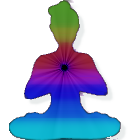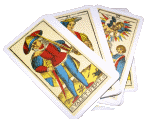
Mary-El Tarot
ACE OF PENTACLES
The Bull, elemental of Earth.
His/her body is strong, solid, muscular and well formed and he has the wings of the silent, nocturnal owl. The owl isnít relevant to me just because it is so fitting in a dark labyrinth; it is also relevant because of an acronym I made up a long time ago. The word is OWL and it is derived from the phrase Ďone who lookedí. In Jewish mysticism you may encounter a story about why God decided to create the universe. At one time he was the entire universe, there was nothing but him. He wanted to see himself, but in order to do so had to remove himself from part of the universe. It was into this empty space, devoid of God, that he poured his ray of light, as a positive manifestation of himself. This is the beginning of the lore of the creation of the Sephiroth and the Tree of Life. One Who Looked, to me, is the name of God after he has become a positive manifestation of the whole universe and then been able to see his own face in the experience of the physical universe, Malkuth. One Who Looked is the living personality of the universe, in the earth plane, if there is such a thing. I am always happy, thinking of this, that the owl is known for its extraordinary vision in the dark with its two giant eyes.
The bull who inspired the main image is the Greek Minotaur, half human and half animal (half earthly and half divine?) who guarded the labyrinth, a symbol of the womb of the earth. This image also contains all of the elements in lesser degree, as the earth plane does. In the upper right corner are the wings for the element of Air. The bottom right corner has stalks of wheat (canít you see it growing on the rolling hills below the Ace of Wands?). The lower left is another spiral and the upper left is the head of a labrys. The words labrys and labyrinth have similar etymological origins in the Latin word labium which means lip or labrum which means the edge or brim of a vessel. The labrys, or double headed axe, resembles the labia of the female vulva and has been used all the way back to the ancient times and into the present as a symbol of the same. The other half of the body below the labrys is the serpent or snake, and together they become a winged serpent, a symbol of the rising kundalini. These are symbols of the groin, genitals, and reproductive organs, male and female, in the creation of the earth and universe, the beginning creative energies fitting for the Ace of Disks.










